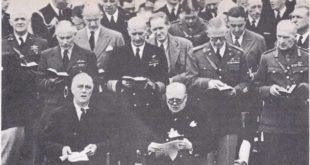Andrei was carving a wooden sleigh. So expert was he in the use of a knife that he could make a toy sleigh, driver and all, in two long winter evenings. Another night would be enough for the horse, which wasn’t difficult, but Andrei always had a hard time with the yoke that went over the neck. The yoke was shaped like a big wishbone and Andrei could never understand why Russian horses wore such high and heavy yokes. “Just like us peasants!” thought Andrei, “We too carry heavy burdens and are little more than slaves.” Andrei thought many things …
Read More »Tag Archives: Kiev
Victory in Europe 1941 – 1945
Even before Pearl Harbour, there had been cooperation between the United States and Britain. In August of 1941, President Roosevelt and Prime Minister Churchill met secretly, on a cruiser at sea off the coast of Newfoundland. There they drew up the Atlantic Charter, a document stating the principles on which they based their hopes for a better future for the world. They pledged that neither country would seek more territory. They hoped that, “after the final destruction of Nazi tyranny,” all men in all lands could “live out their lives in freedom from want and fear,” and they called on …
Read More »Byzantium and Russia 400 B. C. – 1240 A. D.
THE BEGINNINGS of Russian history date back to the centuries when Byzantium was at the height of its glory. A thousand years before that Herodotus, the Greek explorer, found Greek settlements on the northern shore of the Black Sea. They traded with the Scythians, a tribe of nomads living on the open plains that stretched eastward for thousands of miles to the mountains of Asia. Bordering these plains on the north were the forest lands and above them, in the far north, stretched the frozen wastes of the arctic tundra. In all that vast land there were no barriers, no …
Read More »

